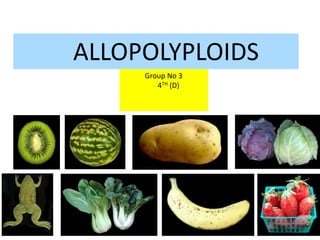Allopolyploid
•Descargar como PPTX, PDF•
2 recomendaciones•2,478 vistas
Denunciar
Compartir
Denunciar
Compartir

Recomendados
Recomendados
Más contenido relacionado
La actualidad más candente
La actualidad más candente (20)
22. Polyploidy in plant breeding in crop improvement

22. Polyploidy in plant breeding in crop improvement
Presentation on Summary of Autopolyploidy and Allopolyploidy

Presentation on Summary of Autopolyploidy and Allopolyploidy
Destacado (10)
As redes sociais vão acabar no dia em que as ideias morrerem.

As redes sociais vão acabar no dia em que as ideias morrerem.
Similar a Allopolyploid
Similar a Allopolyploid (20)
Presentation on Natural Allopolyploidy in Brassica spp

Presentation on Natural Allopolyploidy in Brassica spp
Changes In Number And Structure Of Chromosomes SMG

Changes In Number And Structure Of Chromosomes SMG
Polyploidy, mutation and hybridization with reference to medicinal plants. PH...

Polyploidy, mutation and hybridization with reference to medicinal plants. PH...
Utilization of polyploids and aneuploids in plants

Utilization of polyploids and aneuploids in plants
role of Chromosome variations in crop improvement in cereal crops

role of Chromosome variations in crop improvement in cereal crops
How do autopolyploidy and allopolyploidy differ Only autopolyploidy.pdf

How do autopolyploidy and allopolyploidy differ Only autopolyploidy.pdf
Más de Zohaib Hassan
Más de Zohaib Hassan (7)
Sheesham Decline, Shisham Decline/ Dieback. (Dalbergia sissoo Dieback)

Sheesham Decline, Shisham Decline/ Dieback. (Dalbergia sissoo Dieback)
Different techniques for detection of plant pathogens.

Different techniques for detection of plant pathogens.
Allopolyploid
- 1. ALLOPOLYPLOID ALLOPOLYPLOIDS Group No 3 4TH (D)
- 2. POLYPLOIDY • Polyploidy = the addition of one or more complete sets of chromosomes to the original set. • two copies of each autosome = diploid • four copies of each autosome = tetraploid • six copies of each autosome = hexaploid • The gametes of diploids are haploid, those of tertraploids are diploid, those of hexaploid are triploid, and so on.
- 3. • . Two main types of polyploidy: • autopolyploidy (genome doubling) = the multiplication of one basic set of chromosomes • allopolyploidy = the combination of genetically distinct, but similar chromosome sets. • Autopolyploids are derived from within a single species; allopolyploids arise via hybridization between two species .
- 4. ALLOPOLYPOLIDY autopolyploidy (genome doubling) = the multiplication of one basic set of chromosomes allopolyploidy = the combination of genetically distinct, but similar chromosome sets. Autopolyploids are derived from within a single species; allopolyploids arise via hybridization between two species .
- 5. Allopolyploidy is much more common in nature than autopolyploidy. About 80% of all land plants may be allopolyploids. Red circles indicate instances of allopolyploidy. The blue circle indicates an instance of autopolyploidy. The green square indicates a putative triplication event before the divergence among dicotydelons. The two black ovals indicate an ancestral angiosperm genome duplication (190-230 million years ago) and an ancestral seed-plant duplication (320-350 million years ago).
- 6. Triticum urartu (AA) Aegilops speltoides (BB) T. turgidum (AABB) T. tauschii (DD) T.astivum AABBDD The common bread wheat (Triticum aestivum) is an allohexaploid containing three distinct sets of chromosomes derived from three different diploid species of goat-grass (Aegilops) through a tetraploid intermediary (durum wheat).
- 7. Allopolyploidy in Animals • In animals, allopolyploidy is rare. Allopolyploidy was found in insects, fish, reptiles, and amphibians. For example, Xenopus laevis, the African clawed frog of laboratory fame, is an allotetraploid. No cases of polyploidy have ever been found in birds. Two mammalian species are suspected tetraploids, the red vizcacha rat (Tympanoctomys barrerae) and the golden vizcacha rat (Pipanacoctomys aureus), however, some disagreement exists in the literature.
- 8. Identifying Auto- & Allopolyploidy Autopolyploids typically have multivalent pairing - chromosomes are more or less identical Allopolyploids are variable - bivalent pairing with more genetic divergence - multivalent pairing when closely related
- 9. Characteristics of Allopolyploids • Larger cells • Vigorous plant • Less complex than autopolyploids • Recessive characters may appear less frequent
- 10. species A species B X Hybrid AB during meiosis aborted gamete production Hybrid AB body cells spontaneous genome duplication Duplicated genomes are fertile !! Botanical term: Allopolyploids Hybrid AABB “allopolyploid” successful cell division (fertile) Allopolyploidy arises from hybridization plus genome duplication
- 11. Allopolyploids in Plant Breeding
- 12. Allopolyploids in Plant Breeding • Identify genetic origin of plant species • Produce new plant genotypes and plant species • Facilitate transfer of genes from related species • Facilitate transfer of individual chromosomes or pairs of chromosomes
- 13. The cabbage family: “Triangle of U” Black mustard N=8 N=10+8 BB Brassica carinata Brassica juncea Chinese cabbage, Bok Choi Cauliflower, broccoli, kale Qu i ckTi me™ an d a TIFF (Uncompres sed) decompres sor are needed to see this picture. N=9 N=10 rape seed Indian mustard Canola-type oil seeds Collard green, good for cold climates biodiesel Brassica nigra N=10+9 Brassica olarecea Brassica napus Brassica rapa AABB AA BBCC AAC C N=9+8 CC picture sources: various www.
